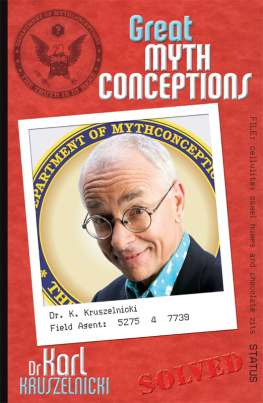To Ganesha, the God of overcoming obstacles.
Thanks for getting us safely out of the Himalayas.
If things get a bit rushed at work, you might grab a quick sandwich at your office desk. On the other hand, you would never dream of eating off the toilet seat, because everyone knows that toilets are dirty, and loaded with germs. But, on average, a desk has 50 times more bacteria per square centimetre than a toilet seat!
Dr Charles Gerba, a microbiologist from the University of Arizona, discovered this fact. Hes Dr Germs. Over the past three decades, hes written some 400 papers on infection and disinfection in peer-reviewed journals.
He solved the problems that the National Science Foundation was having with the waste-water treatment system in the Antarctic at McMurdo Station. He helped out with advice on water-recycling systems for both NASA and the Russian Mir Space Station. He loves his work so much, that he even gave his first son the middle name of Escherichia, which is the E in E. coli , the famous faecal bacterium. He got around family resistance by telling his father-in-law that Escherichia was the name of a king in the Old Testament of the Bible.
From June to August of 2001, he and his team looked for five different types of bacteria E. coli, Klebsiella pneumonia, Streptococcus, Salmonella and Staphylococcus aureus . The team studied offices at four United States locations New York City, San Francisco, Tampa and Tucson. At each site, they tested surfaces three times a day for five days. They sampled 12 different surfaces desktop, telephone receiver, computer mouse, computer keyboard, microwave door button, elevator button, photocopier start button, photocopier surface, toilet seat, fax machine, refrigerator door handle and water fountain handle. The team wanted to measure the effect of cleaning each surface. At each location, one group of employees used disinfecting wipes to clean the surfaces they worked with, while the other group did not. (The study was partly funded by Clorox, a company that makes disinfecting wipes.)

The results were astonishing. In terms of bacteria per square inch (25.4 mm2), they found that the telephone receiver was the filthiest 25 127 (probably because many people often share the same phone). This was followed by the desktop at 20 961, the computer keyboard at 3295 and the computer mouse at 1676. The least contaminated surface was the toilet seat with only 49 bacteria per square inch making it about 400 times cleaner than the desktop. Gerba says that, for bacteria, the desk is really the laptop of luxury. They can feast all day from breakfast to lunch and even dinner. Your desk is the second germiest place in the office.
Pat Rusin from the University of Arizona is not sure why the shared toilet seat, which you would expect to be a maelstrom of maximum microbial activity, is actually one of the cleanest. He said: What we found, and what we are still theorising as to why, is that the toilet seat was always the cleanest site. One theory is that toilet seats are too dry to provide a good home to a large population of bacteria.
The other major finding was that if you went to the trouble of using their sponsors antibacterial wipes, you could drop the bacteria count by about 99.9%.
While I know intellectually that the toilet seat has a lower bacterial count than the desktop, Im not going to have my next snack in the toilet. Perhaps Ill go halfway and wipe down my desktop, not with a germ-laden sponge (10 000 bacteria per square inch), but with a clean disposable tissue.
Flush Toilet with Lid
Up or Down?
Dr Gerba also studied germ counts in the home and discovered the right way to flush the toilet. You should flush with the lid down.
If you flush with the lid up, a polluted plume of bacteria and water vapour erupts out of the flushing toilet bowl. He describes the germy ejecta as Baghdad at night during a US air attack. The polluted water particles float for a few hours around your bathroom before they all land. Some of them will even land on your toothbrush.
Dr Gerba also found that in the home, the kitchen sponge had the highest germ count, followed by the kitchen sink. The lowest bacterial count, out of 15 household locations, was the toilet seat. He said (perhaps jokingly), If an alien came from space and studied the bacterial counts, he probably would conclude he should wash his hands in your toilet and crap in your sink.
So if your toilet is in the bathroom and you flush with the lid up, you are probably brushing your teeth with toilet water. I guess thats one story to tell the males in your household, so that they put the lid down

References
Adams, Cecil, Does flushing the toilet cause dirty water to be spewed around the bathroom?, The Straight Dope , www.straightdope.com/classics/a990416.html.
Murphy, Cullen, Something in the water, The Atlantic , September 1997.
Woods, Kate, Toilet seats cleaner than desk, Medical Observer , 16 April 2004, p. 23.
About 90% of smokers know that smoking is bad for their health and about 60% of smokers want to give up, but cant. Every week, the average GP will hear an addicted smoker say, Look Doc, Im already cutting down. Ive started smoking low nicotine cigarettes. These poor smokers have fallen for the myth that low nicotine cigarettes deliver less nicotine into their bodies.
Nicotine is an addictive drug. In fact, its extremely addictive. Consider smokers who have had their larynx (voice box) removed as a result of a smoking-related disease. This is a very major operation. And yet, 40% of these smokers will, as soon as they recover from the operation, start smoking again.
Tobacco companies could make a zero-nicotine cigarette but they wont, because nobody would buy them. After all, inhaling sugar does nothing for a cocaine addict. Addicted cigarette smokers need their nicotine hit.
A cigarette is an incredibly efficient drug-delivery device luckily for the tobacco companies. It accurately delivers to the brain the precise dose of nicotine needed to ensure continued addiction within 11 seconds of sucking in the smoke. If you want to make somebody addicted, you need a very short time between when they do the action (sucking on the cigarette) and when they get the reward (nicotine in the brain). Smoking nicotine from a cigarette fits the bill perfectly. By the way, the average smoker carries about 40 billionths of a gram of nicotine in each millilitre of blood.
Nicotine can have opposite effects, depending on the dose. At low doses, it stimulates your thinking and increases your heart rate and blood pressure. At high doses, it calms you down and drops your heart rate. Smokers will often subconsciously adjust how hard and how frequently they suck, to get either a low or a high dose.
Will low nicotine cigarettes deliver low levels of nicotine? Yes, but only when they are tested on a sucking machine. However, when a human smokes low nicotine cigarettes, they get as much nicotine as they would from a regular nicotine cigarette.

Smokers need their regular nicotine hit, so when they change to a low nicotine cigarette, they just suck harder and more frequently in order to get the same dose. Unfortunately, when you suck harder on a burning cigarette, you also suck in more carbon monoxide. This forces your body to make more haemoglobin, which makes your blood more sludgy which increases your chances of a stroke. So its actually more dangerous to get your regular nicotine dose from a low nicotine cigarette.


















